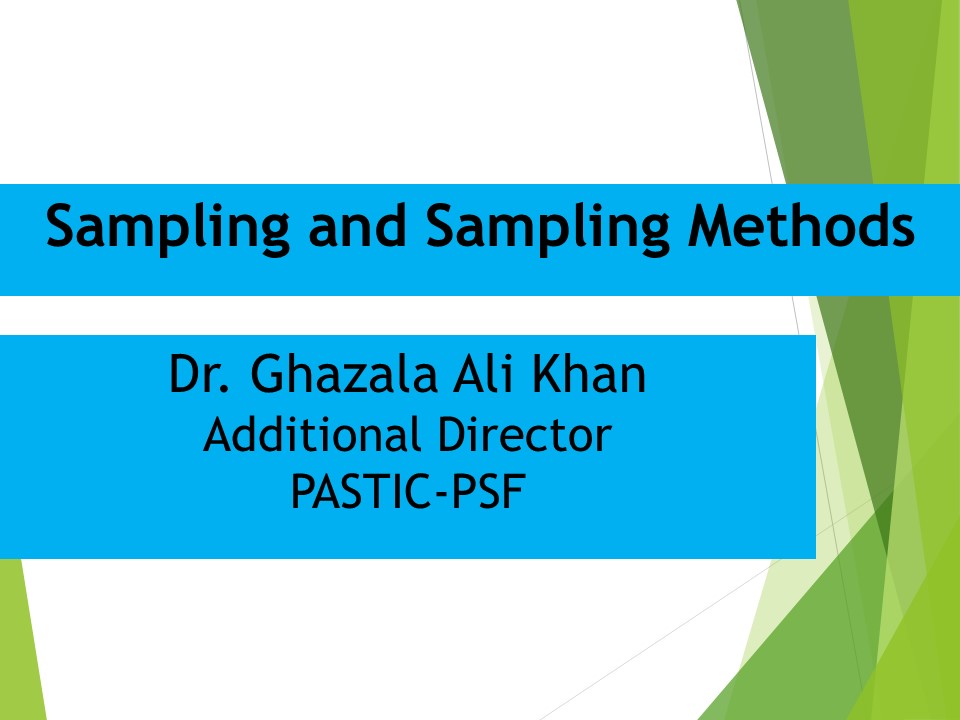About the instructor: Dr. Ghazala Ali Khan – Additional Director – PASTIC-PSF
Sampling
PPS (Probability Proportional to Size) Sampling
▶Is a sampling technique in which the selection of units is proportional to their size (experimental Population).
▶Where the size of a unit is typically measured by a characteristic such as population, revenue, or number of employees.
Scientific sampling
▶Also known as probability sampling, is a research methodology used to select a representative subset (sample) from a larger population.
▶This approach ensures that the sample is representative of the population.
▶Allowing researchers to generalize their findings to the larger group.
The key characteristics of scientific sampling
1.Random selection:
Participants are chosen randomly from the population, reducing bias and ensuring that each individual has an equal chance of being selected.
2.Representative:
The sample is representative of the population in terms of relevant characteristics, such as demographics, behaviors, attributes , characteristics, qualities, or traits.
3.Probability:
Each member of the population has a known probability of being selected, allowing researchers to calculate the margin of error and confidence intervals.
Probability is a measure of the likelihood of an event occurring.
Probability theory is a branch of mathematics that deals with the study of chance events and their probabilities. It has numerous applications in fields such as statistics, engineering, economics, and finance.
What is Probability:
It is a number between 0 and 1 that represents the chance or probability of an event happening.
-0 represents an impossible event
-1 represents a certain event
– A value close to 0 represents an unlikely event
-A value close to 1 represents a likely event
-Probability is often expressed as a percentage or a fraction, and it is used to quantify uncertainty and make predictions about future events.
We have a bag of 5 red marbles and 3 blue marbles.
Question:
What is the probability of drawing a red marble from the bag?
Answer: There are a total of 8 marbles (5 red + 3 blue).
The number of favorable outcomes (drawing a red marble) is 5. So, the probability is:
Probability = Number of favorable outcomes / Total number of outcomes = 5/8 = 0.625
This means that the probability of drawing a red marble is 0.625 or 62.5%.
In simple terms, if you draw a marble from the bag many times, you would expect to get a red marble about 62.5% of the time.
4.Systematic:
The sampling process is systematic, using a predetermined procedure to select participants, such as random number generators or stratified sampling techniques.
Stratified Sampling:
This sampling allows researchers to divide particular populations into subgroups called Strata
Example:
Institute….. 03-Subjects…. Take sample from each subject… for analysis
Common types of scientific sampling include:
1. Simple Random Sampling: Each member of the population has an equal chance of being selected.
2. Stratified Sampling: The population is divided into subgroups, and a random sample is selected from each subgroup.
3. Systematic Sampling: Every nth member of the population is selected, where n is a fixed number.
4. Cluster Sampling: A random sample of groups (clusters) is selected, and all members of each cluster are included in the sample.
Importance of Scientific sampling
Scientific sampling is essential in research, as it allows researchers to:
1.Generalize findings: Results can be applied to the larger population with a known degree of accuracy.
2.Minimize bias: Random selection reduces the influence of personal biases and ensures a representative sample.
3.Increase efficiency: Sampling is often more feasible and cost-effective than studying the entire population.
4.By using scientific sampling, researchers can ensure that their findings are reliable, valid, and applicable to the larger population.
Factors that influence sample representative-ness
▶3 factors that influence sample representative- ness
•Sampling procedure
•Sample size
•Participation (response)
▶When might you sample the entire population?
•When your population is very small
•When you have extensive resources
•When you don’t expect a very high response
SAMPLING BREAKDOWN


Process
•The sampling process comprises several stages:
–Defining the population of concern
–Specifying a Sampling Frame, a setof items or events possible to measure
–Specifying a sampling method for selecting items or events from the frame
–Determining the sample size
–Implementing the sampling plan
–Sampling and data collecting
–Reviewing the sampling process
Population definition
•A population can be defined as including all people or items with the characteristic one wishes to understand.
• Because there is very rarely enough time or money to gather information from everyone or everything in a population, the goal becomes finding a representative sample (or subset) of that population.
•Note also that the population from which the sample is drawn may not be the same as the population about which we actually want information. Often there is large but not complete overlap between these two groups due to frame issues etc .
•Sometimes they may be entirely separate – for instance, we might study rats in order to get a better understanding of human health, or we might study records from people born in 2008 in order to make predictions about people born in 2009.
SAMPLING FRAME
•In the most straightforward case, such as the sentencing of a batch of material from production (acceptance sampling by lots), it is possible to identify and measure every single item in the population and to include any one of them in our sample. However, in the more general case this is not possible.
•There is no way to identify all rats in the set of all rats.
•Where voting is not compulsory, there is no way to identify which people will actually vote at a forthcoming election (in advance of the election)
•As a remedy, we seek a sampling frame which has the property that we can identify every single element and include any in our sample .
•The sampling frame must be representative of the population
Also read: Literature Review Lecture By Dr. Ghazala Ali Khan
Follow Us on

